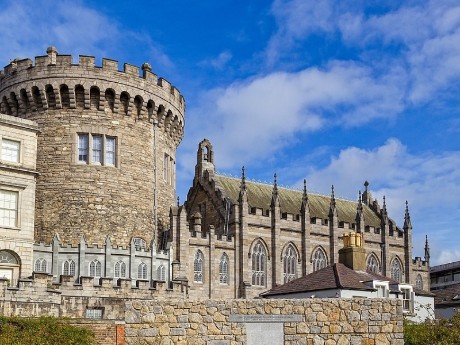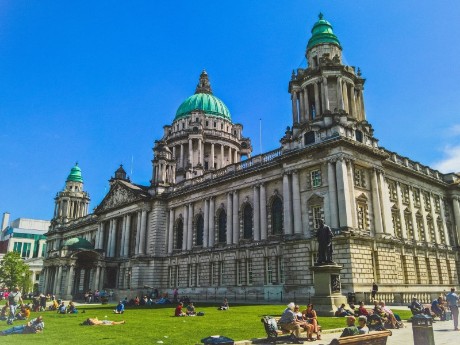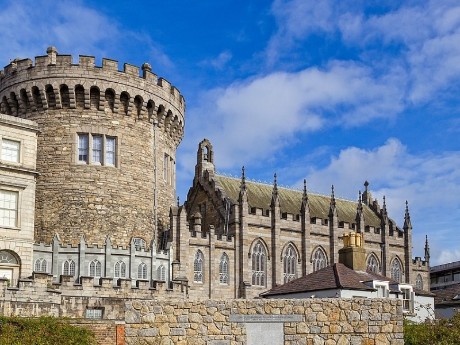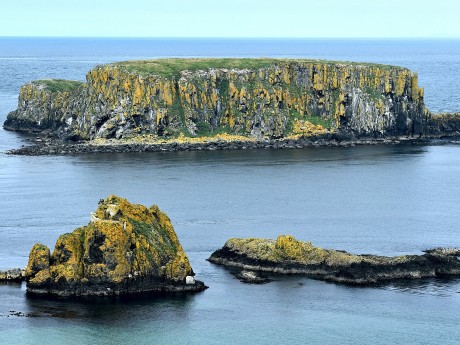Ireland: Dublin & Belfast
Embark on a captivating journey through Ireland's vibrant cities, where you can delve into Dublin's literary legacy at Trinity College, and then head north to Belfast to uncover the Titanic's poignant history at the Titanic Belfast museum. Begin in Dublin, the capital of Ireland, a city steeped in history and rich in culture. Visit the iconic Dublin Castle, the largest castle in Ireland, or admire the stunning architecture of St. Patrick's Cathedral.
Read more
Embark on a captivating journey through Ireland's vibrant cities, where you can delve into Dublin's literary legacy at Trinity College, and then head north to Belfast to uncover the Titanic's poignant history at the Titanic Belfast museum. Begin in Dublin, the capital of Ireland, a city steeped in history and rich in culture. Visit the iconic Dublin Castle, the largest castle in Ireland, or admire the stunning architecture of St. Patrick's Cathedral. A must-see attraction is the Trinity College Library, home to the famous Book of Kells. Don't leave without trying some of the local delicacies, such as fish and chips, or sipping on a pint at the Guinness Storehouse. Next, make your way to Belfast, a city with a turbulent history and stunning natural beauty. The Titanic Belfast museum, which tells the story of the famous ship's construction in the city, is a must-see attraction. Take a tour of the city's political murals and learn about The Troubles, a period of sectarian conflict that ended in 1998. For a scenic adventure, head out of the city and explore the magnificent Giant's Causeway. Waterviews strives to offer accommodation options within walking distance of water and/or in an area of touristic interest. Our prices include taxes (but excludes local tourist taxes). Customize your trip to your personal preferences with optional activities (hit the “Add Activities’’) or change hotels, etc. Contact us for customization at no extra cost at: Service@waterviewstravel.com
Destinations
- Dublin
- Belfast
- Dublin
Itinerary
Dublin

The vibrant, world-renowned capital of Ireland is an essential stop in any visit to the country. Dublin is a dynamic hub buzzing with life, and offers something for every traveller with its mixture of historical buildings and modern architecture within a compact city centre. Spend the day visiting museums and learning about Ireland’s literary legends, before sampling some of the famous Irish charm in one of Dublin’s many pubs and enjoying some live music while chatting to friendly and welcoming locals over a Guinness or two.
Read more
The vibrant, world-renowned capital of Ireland is an essential stop in any visit to the country. Dublin is a dynamic hub buzzing with life, and offers something for every traveller with its mixture of historical buildings and modern architecture within a compact city centre. Spend the day visiting museums and learning about Ireland’s literary legends, before sampling some of the famous Irish charm in one of Dublin’s many pubs and enjoying some live music while chatting to friendly and welcoming locals over a Guinness or two.
Additional Information
History
Founded in 841, Dublin was originally settled by Vikings among a population of Celtic tribes. In the 9th century the Danes captured Dublin and had control until 1171 when they were expelled by King Henry II of England. By the 14th century the king of England controlled Dublin and the surrounding area referred to as “the Pale”.
When the English Civil War ended in 1649, Oliver Cromwell took over. Dublin experienced huge growth and development in the 17th century because many Protestant refugees from Europe came to Dublin. By the 17th century Dublin was the second largest city in the British Isles, only behind London, and a period when great Georgian style buildings were constructed that still stand today. Georgian style architecture was popular from 1720 to 1840 during the times when George I, George II, George III, and George IV of England were ruling.
In 1800, the Act of Union between England and Ireland abolished the Irish Parliament. From this point on, the Irish worked to gain their independence from England, which they finally won in 1922. The Easter rising in 1916 and the War of Independence greatly helped Ireland win their freedom.
A failed attempt to take over the several important buildings, among them the General Post Office on O'Connell Street, led to the arrest of hundreds and execution of 15, now considered martyrs for the cause. Many believe that this event helped gain sympathy for the fight for independence from Britain.
Orientation
Dublin is divided by the River Liffey. On the north side of the Liffey is O'Connell Street — the main thoroughfare, which is intersected by numerous shopping streets, including Henry Street and Mary Street, the busiest shopping district in the city. On the south side are St. Stephen's Green and Grafton Street, the second busiest and most upmarket shopping area, Trinity College, Christ Church and St. Patrick's Cathedrals, the main branch of the National Museum, and many other attractions.
Dublin postal districts range from Dublin 1 to Dublin 24. As a rule, odd numbers are given to areas north of the River Liffey, while even numbers are given to areas south of the river (exceptions are Dublin 8 and 20 which span both sides of Liffey). Usually, the lower the district number, the closer to the city centre.
Although some of Dublin's finest Georgian architecture was demolished in the mid-20th century, a remarkable amount remains. At one point these buildings were considered a reminder of the past British imperialism and many were demolished without regard to their beauty and architectural significance and replaced with modernist or pastiche office blocks, parts of St. Stephen's Green (Dublin 2) being a prime example. Thankfully, attitudes have changed significantly, and Dubliners are now rightly proud of their impressive buildings from all eras.
© Sourced from Wikivoyage
Belfast

Since the early 19th century, Belfast has been a major and important port and a birthplace for world famous Titanic. Nowadays this historical event is remembered and honoured with a whole neighbourhood in Belfast, named Titanic Quarter. Besides its historical and cultural sightseeing, Belfast has many outstanding restaurants and a very lively nightlife to offer. From traditional pubs to fancy cocktail bars up to crowded clubs - there is a place for every taste. Many of the bars have live music and at some point the party moves out on the street
Read more
Since the early 19th century, Belfast has been a major and important port and a birthplace for world famous Titanic. Nowadays this historical event is remembered and honoured with a whole neighbourhood in Belfast, named Titanic Quarter. Besides its historical and cultural sightseeing, Belfast has many outstanding restaurants and a very lively nightlife to offer. From traditional pubs to fancy cocktail bars up to crowded clubs - there is a place for every taste. Many of the bars have live music and at some point the party moves out on the street
Additional Information
Belfast gained notoriety around the world during The Troubles (1969-1997) due to the frequency of gun and bomb attacks in the city. Parts of Belfast were effectively no-go areas for security forces and therefore took on a lawless quality. Today, the scars of Belfast's troubled past make it an intriguing destination for travellers from around the world.
Since the signing of the Good Friday Agreement in 1998, most of the politically-motivated violence has evaporated. Belfast has since been awarded the accolade of being the safest city in the UK, based on a comparison of nation-wide crime figures, and, as part of its commitment to maintain peace, now seeks tourism from around the world, especially from countries other than the Irish Republic and the rest of the UK.
Those who live in Belfast tend to either absolutely love the city or loathe it, although the outsider's perspective tends to be more forgiving, as Belfast was voted the fourth best city in the UK for a city break in the Guardian/Observer travel awards. Needless to say, a visit to Belfast will be rewarded by a glimpse of a unique city that has finally begun to celebrate, rather than fight over, its place as a cultural meeting-point of Britain and Ireland. Belfast is certainly exhibiting an air of determined optimism, with new hotels, bars, restaurants, clubs and shops opening at an incredible rate. It is a city that is proud of its Victorian and Edwardian heritage and efforts to restore historic buildings are proving successful. Tourism is on the increase in Northern Ireland, especially among those seeking a weekend away or short break in Ireland as Belfast can offer a significantly cheaper and more rewarding alternative to the busier, more expensive and more tourist-driven Dublin.
Belfast remains a great place to explore, as it is still relatively undiscovered compared with its neighbour in Dublin and is ideal for the tourist who enjoys a city with character, yet still has a raw, unspoilt energy. A visit to the capital of Northern Ireland will provide a more stimulating trip as, once you scratch the surface, it is easy to see beyond the ethno-political conflict of past years. It is a city which has changed dramatically in a decade due to this peace and prosperity and you will be greeted with warmth from locals who feel a new-found sense of pride in their city. Indeed, the old cliche that you will be welcomed like an old friend by the patrons of Belfast's many pubs and bars is actually true, as the locals love to find out what draws you to their little part of the world and, of course, they like the chance to share a little bit of their history with you! Ask any local and they will tell you that a trip to Belfast will mean that you learn far more about the Irish and British psyche than a trip to a cheesy Irish pub in Dublin or on a tourist-orientated tour in London.
Some recent events, mostly the flag protests, may have put people off going to Belfast but violence is minimal and more or less peaceful.
In recent times, Belfast has also gained some degree of international fame for being the production centre of the famous television series Game of Thrones.
Tourist information
© Sourced from Wikivoyage
Dublin

The vibrant, world-renowned capital of Ireland is an essential stop in any visit to the country. Dublin is a dynamic hub buzzing with life, and offers something for every traveller with its mixture of historical buildings and modern architecture within a compact city centre. Spend the day visiting museums and learning about Ireland’s literary legends, before sampling some of the famous Irish charm in one of Dublin’s many pubs and enjoying some live music while chatting to friendly and welcoming locals over a Guinness or two.
Read more
The vibrant, world-renowned capital of Ireland is an essential stop in any visit to the country. Dublin is a dynamic hub buzzing with life, and offers something for every traveller with its mixture of historical buildings and modern architecture within a compact city centre. Spend the day visiting museums and learning about Ireland’s literary legends, before sampling some of the famous Irish charm in one of Dublin’s many pubs and enjoying some live music while chatting to friendly and welcoming locals over a Guinness or two.
Additional Information
History
Founded in 841, Dublin was originally settled by Vikings among a population of Celtic tribes. In the 9th century the Danes captured Dublin and had control until 1171 when they were expelled by King Henry II of England. By the 14th century the king of England controlled Dublin and the surrounding area referred to as “the Pale”.
When the English Civil War ended in 1649, Oliver Cromwell took over. Dublin experienced huge growth and development in the 17th century because many Protestant refugees from Europe came to Dublin. By the 17th century Dublin was the second largest city in the British Isles, only behind London, and a period when great Georgian style buildings were constructed that still stand today. Georgian style architecture was popular from 1720 to 1840 during the times when George I, George II, George III, and George IV of England were ruling.
In 1800, the Act of Union between England and Ireland abolished the Irish Parliament. From this point on, the Irish worked to gain their independence from England, which they finally won in 1922. The Easter rising in 1916 and the War of Independence greatly helped Ireland win their freedom.
A failed attempt to take over the several important buildings, among them the General Post Office on O'Connell Street, led to the arrest of hundreds and execution of 15, now considered martyrs for the cause. Many believe that this event helped gain sympathy for the fight for independence from Britain.
Orientation
Dublin is divided by the River Liffey. On the north side of the Liffey is O'Connell Street — the main thoroughfare, which is intersected by numerous shopping streets, including Henry Street and Mary Street, the busiest shopping district in the city. On the south side are St. Stephen's Green and Grafton Street, the second busiest and most upmarket shopping area, Trinity College, Christ Church and St. Patrick's Cathedrals, the main branch of the National Museum, and many other attractions.
Dublin postal districts range from Dublin 1 to Dublin 24. As a rule, odd numbers are given to areas north of the River Liffey, while even numbers are given to areas south of the river (exceptions are Dublin 8 and 20 which span both sides of Liffey). Usually, the lower the district number, the closer to the city centre.
Although some of Dublin's finest Georgian architecture was demolished in the mid-20th century, a remarkable amount remains. At one point these buildings were considered a reminder of the past British imperialism and many were demolished without regard to their beauty and architectural significance and replaced with modernist or pastiche office blocks, parts of St. Stephen's Green (Dublin 2) being a prime example. Thankfully, attitudes have changed significantly, and Dubliners are now rightly proud of their impressive buildings from all eras.
© Sourced from Wikivoyage





